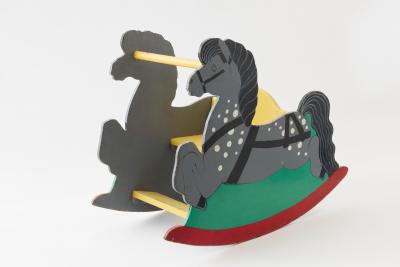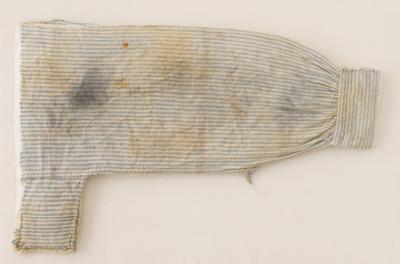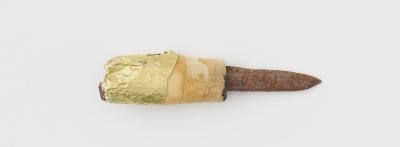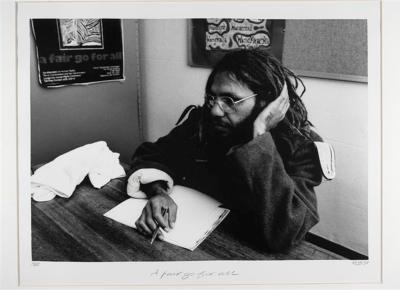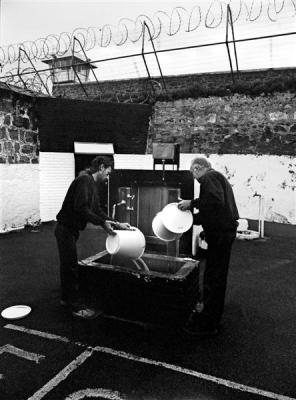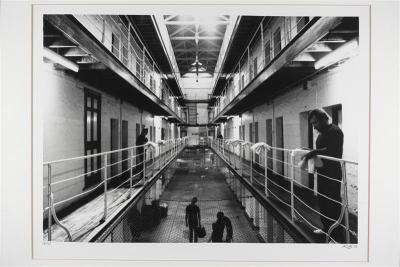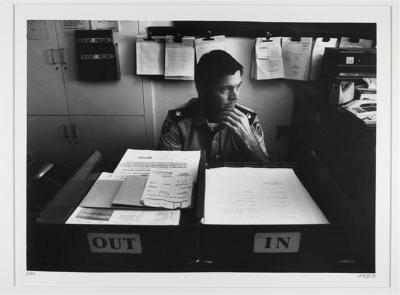Convict Establishment Baton
c. 1850 - 1868Long, thin, cylindrical, black painted, solid wooden baton. Long wooden shaft with a rounded end, which tapers slightly inwards towards the handle. The handle is carved from the same piece of wood, with ten high, rounded ridges, and a rounded wooden cap at the end. The surface of the baton is painted black, including the handle. There are some chips and areas of paint loss on the surface. Painted horizontally down the shaft of the baton, covering most of the length, in gold letters is, [...]CONVICT [...]/ WESTERN AUSTRALIA’. There is evidence of a word being present next to ‘CONVICT' however the surface has been scratched away, possibly deliberately. At the end of the baton is painted a gold and red crown motif. Underneath the crown, painted in gold cursive letters, is ‘[...] R'. There is evidence of another letter preceding the ‘R' however this has been scratched off, along with the left side of the crown motif, as part of the previous defacement of the baton.
This baton belonged to Samuel Dawes, the grandfather of the donor. Samuel Dawes served in the English Army in World War One before emigrating to Western Australia with his wife Elizabeth Marquess Campbell McLean in circa 1925. After arriving, they lived in Subiaco and had three children, all girls, one of which was the donor’s mother, Emma Jean Dawes.
When World War Two began, Samuel Dawes was contacted by the British Military, who had his updated contact details in Australia. They asked Samuel if he would be willing to assist the Australian Military authorities by volunteering as a guard at Fremantle Prison while it was being used as an internment camp and military prison. Samuel accepted and became a guard of Prisoners-of-War and internees at Fremantle Prison. As part of his duties, he also went out into the community to collect people for interment and fined those who had gone missing without permission.
This baton was given to Samuel on his arrival at Fremantle Prison to assist him with his duties. It is presumed the baton had been left on site after the convict period, before being found and redistributed to the new volunteer guards during the Second World War. Samuel Dawes was a guard at Fremantle Prison from 1939 to 1944.
The missing word on the baton, which from other examples in the Western Australian Museum, can be presumed to be ‘ESTABLISHMENT’, has been missing for as long as the donor can remember. The donor is unsure at what point it was removed.
The donor remembers the baton once having a thin leather strap attached to the end of the handle. This strap has since been lost.
Details
Details
[...]CONVICT [...]/ WESTERN AUSTRALIA’.
Samuel Dawes is featured in a photograph of the 11th Australian Detention Staff from 1944, in the Fremantle Prison Collection (2000.101).
This baton would have been supplied by the British Government for use at the Convict Establishment between 1850 and 1868. Carried by Prison Guards to subdue convicts, the baton, or truncheon, remains a popular tool for modern law enforcement officials in Australia and overseas.
In March 1940, the Australian Army took over part of Fremantle Prison as a military detention centre, becoming the 11th Australian Detention Barrack. Prisoners were separated as SNLR (Services No Longer Required - men discharged from the army prior to serving their sentences) and SUDs (Soldiers Under Detention), who were still considered members of the Australian military forces. The SNLR were housed in New Division, and SUD in 3 and 4 Division.
There was tension between the state-operated Prison and the Commonwealth-run Detention Barracks. In 1943 Prison authorities were instructed to remove all civilian prisoners, prompting a protest to the Premier, who then wrote to the Prime Minister. This led to a re-examination of the original Order-in-Council, which revealed that only the area known as New Division was demarcated to be used by the Military.
Records dating from as late as 1945 show that Fremantle Prison was still housing military prisoners, though it is possible that use for this function extended until 1946.

